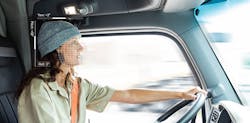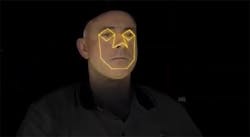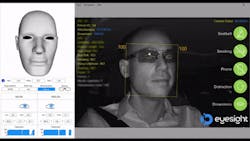With apologies to George Orwell, sometimes management having a camera constantly trained on their workers isn’t as dystopian as it’s made out to be. The application matters.
If there’s an all-seeing eye run by Big Brother in accounts payable leering into every cubicle ensuring productivity, that’s a clear privacy breach — even if you catch them playing Solitaire. Move the debate to the inward-facing cameras of a Class 8 semi cab, which provide an extra layer of safety to prevent accidents caused by fatigued or distracted driving, and the debate of civil liberty vs. public safety can get much murkier.
There are many who don’t want anyone monitoring them no matter what.
“If the truck I’m in ever gets a camera installed in it facing me…this home where I live in, I will stop the truck and quit on the spot,” YouTuber Trucker Josh VLOGS said in 2017. The channel, which has 96,000 subscribers, has more than 23,000 views and a thumbs up ratio of 1,100+ thumbs up to 34 thumbs down. It seems many other truckers agree with him.
But the argument could be made that human life trumps a driver’s fear that somebody’s constantly watching them or the fleet manager’s fear that they may quit. Globally, there are about 1.3 million traffic fatalities a year, and camera technology has been proven to catch drowsy or distracted driving before it escalates into an accident.
According to Seeing Machines, an Australian company that sells the Guardian AI-enabled driver monitoring systems (DMS) that detect distracted or fatigued driving, their technology has intervened in 150,000 fatigue events over a recent 12-month span and nearly 6 million distracted events overall. This covers 2.4 billion miles of service.
The infrared camera points at the driver’s eyes and the video data are run through highly trained algorithms looking for tell-tale signs of sleepiness, such as those lackadaisical blinks that last too long, as well as moments of distraction, such as the head turned away from the road for more than five seconds. It even works while when the driver wears sunglasses and a hat.
If the system discovers a pre-set tolerance has been exceeded, it will signal to the driver via audio alerts and even haptic feedback from the driver seat, like rumble strips for your backside. If the alerts continue unabated, the data is sent to the Guardian center for verification, and then to the fleet manager to intervene directly, maybe calling for the driver to pull over or to send a relief driver.
“We don’t film drivers,” said Seeing Machines' Paul McGlone, explaining how the IR video and location data is only saved when a fatigue or distortion event takes place, and that data is heavily encrypted.
At no point is the camera collecting traditional video, like the one that YouTuber inside the cab to rail against cameras in the cab.
“Tracking time and logbooks, whether they be manual or electronic, were really the first foray into managing fatigue, McGlone noted, but this monitoring solution is better because fleets are “managing on an individual basis in real-time.”
He calls it a “risk-based approach rather than a ‘one-size-fits-all’ approach.”
This is because instead of relying on regulators, each fleet defines the amount of time it takes to set off the system, what happens after in terms of alarms, and what the plan is if the driver keeps setting off the alarms.
“This is how people can start to really make a difference versus just filling out a form and processing them once a week,” McGlone said.
For an in-depth look at the benefits of truck cameras, check out Fleet Owner's 5-part feature here.
One Australian fleet has integrated Guardian into their scheduling system, adding an extra level of automation to the fatigue event to respond more efficiently and proactively if a driver needs to pull over and rest, for example.
Seeing Machines has also partnered with National Transport Insurance in Australia to provide Guardian users with better policy benefits and incentives.
As for the pushback against cameras in America, as well as Australia, from drivers, he called it simply “a normal human reaction to change.”
With data such as an 80% drop in distracted and fatigue events, reported by a European refridgerated carrier, the argument against this tech in the truck becomes more difficult.
And the change in opinions has picked up too much momentum to stop.
“We certainly have an inflection point where I think we're going to see the coalition of regulations, industry bodies, and fleet owners come together to deliver on this commitment to reduce fatigue and distraction,” McGlone said.
“Eye" am inevitable
Over in Europe, there is no weighing of freedom against security. The security vibes are heavy with bodies such as the European New Car Assessment Program (EuroNCAP) pushing stricter safety standards and the European Council enforcing mandatory advanced safety systems on cars, trucks, and buses made mid-2022 and beyond.
Among the myriad technologies included? Driver attention monitoring and advanced distraction recognition.
A Tel Aviv-based computer vision company tracking human movement called Eyesight Technologies sensed driver monitoring was a growing trend and about three years ago started to focus more intently on the automotive sector.
And they realized the best place to look for improving safety was not outward at the road, but within the cab.
“With all the sophisticated systems out there deployed outside of the vehicle, [looking at] traffic lanes and signs and pedestrians and other vehicles, the real problem typically sits behind the steering wheel,” said Tal Krzypow, Eyesight’s vice president of product. “You have to monitor the driver if you're trying to prevent the collision.”
Eyesight’s DMS edge products include the OEM and Tier 1-level Driver Sense and the aftermarket Fleet Sense.
He cited National Highway Traffic Safety Administration findings that 74% of distracted driving accidents occurred due to a 3-second lapse in driver attention, while a AAA Traffic Safety Foundation study found 21% of all road fatalities were due to drowsy driving.
“Our two-layer solution analyzes the facial cues and actions of the driver and then logic algorithms translate the visual cues into the physiological state of the driver in terms of drowsiness, distraction, and identity management,” Krzypow explained.
In layperson’s terms, it recognizes unsafe patterns much like the Guardian tech for head bobs and lingering glances, but drills down to even recognize if a phone is being used, a seat belt isn’t worn or a cigarette is being smoked.
Eyesight got the idea form China, which is tamping down on these dangerous driving dangerous practices and has enacted regulations in three provinces in 2018 and more expected this year. Krzypow said some Chinese drivers would cheat the system by buckling the seat belt and then sitting on top of it. Eyesight’s AI would recognize that scam immediately.
None of the video is recorded and no image is sent to the cloud for processing.
“It's typically about the more immediate warning for the driver to help them refocus on the road if they're not, and they're already so drowsy to make them pay attention and try to keep them awake,” Krzypow said. The fleet can get alerts to intervene as well.
Krzypow understands there is bound to be pushback, as drivers resist anything that tells them they are behaving badly, but a fleet must consider in the case of an accident, not only the potential loss of life, but the cost of the cargo, truck downtime, and shipper penalties.
“The damage is exponential compared with the private cars accident, so for fleets, the level of responsibility required on the driver is significantly higher,” he said.
And the easiest way to ensure privacy here is through compliance, as Orwellian as that sounds.
“If the driver is okay, if they're behaving like they should know, no alert will be generated,” Krzypow maintained.
And as far as trusting drivers, you may be able to use the honor system with majority of them, but what about in instances where the driver is doing drugs and using his cab as a beat factory?
He also said that the inward camera works even better in conjunction with the advanced driver assistance systems (ADAS), and could at some point the system could activate the brakes if the driver falls asleep.
“The more you adopt this technology and the more that you integrated with other active safety systems, the more meaningful it will be,” he said.
Change management
Once a fleet decides to invest in any of the numbers of inward-facing solutions out there, the onus is on them to convince their drivers they aren’t Big Brother, but more of a big brother, someone who is genuinely concerned for their safety, not there to control their every move.
“With any type of technology, it's the educational process, which is key to the success of the product,” said Jason Louis, vice president of safety for Coach USA, which manages a fleet of 5,000 buses, ranging from the yellow school variety to double-decker buses.
In 2016, the company decided to integrate Guardian after a fatigue-related accident involving transporting workers to a mine. The tech is now in 250 vehicles, which includes all the buses on cross country routes.
“We were looking to address the fatigue initially, but then we saw the benefit of reducing distractions and cell phone events,” Louis said.
Prior to installation, Coach started educating the drivers at each location.
“We explained what the product does, what it doesn't do, how it's going to benefit them,” Louis said. “To get that buy-in was key to the success and it's like anything else, it just took a little bit of time, to overcome that resistance of ‘This is Big Brother watching me.’”
After a 30-day baseline period, where the system was watching but not alerting, the solution went active and Louis said the benefits were immediately noticed.
“We saw a sharp decline over the next several months of those types of events,” Louis said.
And then the team was not private about those results.
“We put an educational video together for the drivers where we brought some drivers in that it actually benefited them in the way of avoiding an accident,” Louis said.
About the Author
John Hitch
Editor
John Hitch is the editor-in-chief of Fleet Maintenance, providing maintenance management and technicians with the the latest information on the tools and strategies to keep their fleets' commercial vehicles moving. He is based out of Cleveland, Ohio, and was previously senior editor for FleetOwner. He previously wrote about manufacturing and advanced technology for IndustryWeek and New Equipment Digest.



